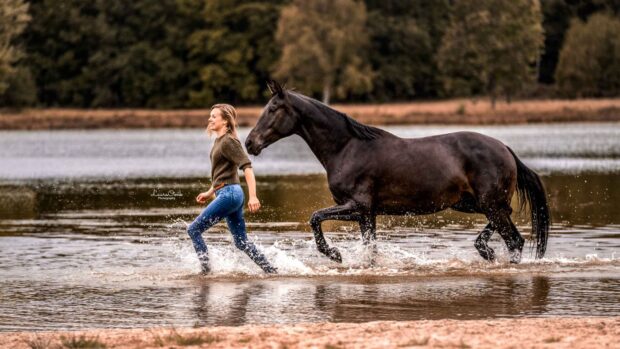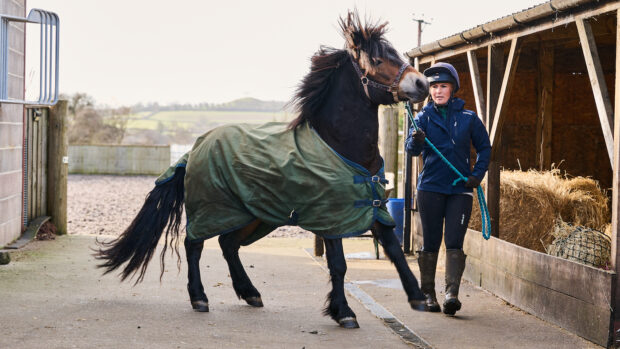When you confidently know how to lunge a horse, then you might be interested to learn how to lunge a young horse, especially if you have aims of working with a new horse or a project over the forthcoming months.
Why should I lunge my young horse?
Lungeing is one of the first training exercises a young horse learns during his early education. Some of the benefits include:
- Encourages a horse to move forwards freely before being ridden
- Gets the horse used to tack, including a bridle and a roller or a saddle
- Helps the horse to become balanced on his own before the weight of a rider is added during the later stages of training
- Helps develop muscles and body condition
- Aids the bond between rider and handler; the horse becomes responsive to voice commands which can be used when he is being ridden
- The horse gets used to light pressure
What age should you start lungeing a horse?
You can begin to lunge your horse when he is mentally and physically ready to start light work. Every horse is an individual and it’s important to ensure that the horse is sufficiently developed to commence any type of training.
As with all forms of training, lungeing work should be introduced gradually, and sessions should be short in duration and low in intensity. In the early stages, it’s important to do little and often. Lungeing is hard work for the horse as he is working on a constant circle so always ensure that he is strong and developed enough before you start training him. If you are unsure, consult with your vet.
If you are inexperienced at lungeing, it is advisable to ask a trainer or someone with more experience to teach your horse before you take over. Practice with a horse who knows how to lunge before you try lungeing a younger horse.
Before you begin lungeing a horse he should be established in his ground work and should lead confidently with good manners. He should be able to walk in-hand and have respect for the handler before you start lungeing, too. Before you start lungeing, you could also train your horse on the long reins, as this establishes control by developing steering and brakes.
Tips on how to lunge a young horse
If you want to know how to lunge a young horse, then four-time Olympian Jennie Loriston-Clarke MBE FBHS has some helpful recommendations to follow. Jennie’s advice has a particular focus on training and exercising young horses on the lunge, but the legendary rider and trainer’s tips can be applied to horses of any age.
1. Walk the horse in-hand on the right rein around the area where it is going to be worked before you start so it can get its bearings. If you don’t have a lunge pen, you can improvise and make a suitable area in the corner of a field or by cutting off your arena with blocks or wings and poles. Once the horse is settled waking in-hand then change the rein and lead it in the opposite direction.
“By showing it the lunging area on the right rein first, this means it will leap inwards away from the handler if scared or spooky, rather than over the top you,” explains Jennie.
2. Expect the horse to behave differently if you are in a different or new place. Always be alert as accidents can happen quickly, particularly if the horse is young and fresh.
“When sending a horse out on the lunge be aware that they can turn away from you and kick towards you, as well as turning in and turning around,” says Jennie.
3. Dress appropriately when lunging a horse. Ensure you are wearing a riding hat, gloves and have suitable footwear. If you do not have pen or penned off area, it is helpful in the beginning to have an assistant standing in the open area of the arena to help guide the horse around the circle if needed.
4. Don’t be in a hurry: “With young horses you have to give them the time they need to understand what you want of them. Have patience, don’t start working with them if you don’t have plenty of time to give them, you need to allow the horse to learn in its own time,” says Jennie. “If the horse learns in its first lesson to walk on and to halt, then praise in a soft voice as a reward. Don’t muddle the horse by asking too much in each session.”
5. Start lunging with a light contact on a big circle.
“Have a light feel on the lunge rein, keep your elbows bent like when you are riding and remember to give with the rein when the horse accepts the contact and the circle,” adds Jennie.
6. Remember that your voice is key when lunging a horse.
“Your voice is one of the most important things in lunging and riding and is your first communication of the natural aids. Start using it to give instructions — the horse should recognise it and be obedient to it — a soft voice to calm and slow down, a sharper voice to activate and tighter body language. You don’t want them to be frightened of you, but to have respect,” continues Jennie.
7. Use your body language as well as using your voice.
“Slow your body’s direction on the circle and relax when asking the horse to slow down and act positively to encourage it to go,” says Jennie.
8. Limit canter work.
“There is no real need to canter young horses on the lunge, you are better to train them in canter on straight lines when you are riding them,” says Jennie.
9. Introduce an outside side rein before using both.
“Putting the outside side rein on when lunging teaches the horse to accept the outside rein and helps the horse to become better balanced and carry itself better,” adds Jennie. “Don’t overuse it though and give the horse plenty of rest in its neck without the side rein as it will tire easily. Always release the side rein when changing the rein. Introduce the second side rein on the inside when the horse is happily accepting the outside side rein.”

How to lunge a horse – your essential guide

6 bits of lunging kit you need on your yard
Are you planning to lunge your horse this winter? Then check out our selection of lunging kit that you're likely

Subscribe to Horse & Hound magazine today – and enjoy unlimited website access all year round
Horse & Hound magazine, out every Thursday, is packed with all the latest news and reports, as well as interviews, specials, nostalgia, vet and training advice. Find how you can enjoy the magazine delivered to your door every week, plus options to upgrade your subscription to access our online service that brings you breaking news and reports as well as other benefits.




